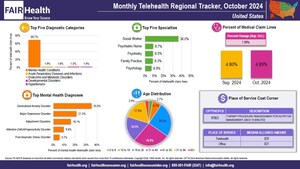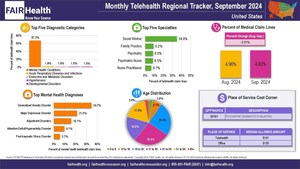Telehealth Claim Lines Increase 8,336 Percent Nationally from April 2019 to April 2020
Telehealth Growth in Northeast Is 26,209 Percent When Comparing the Same Period
Findings from FAIR Health's Monthly Telehealth Regional Tracker Suggest Continuing Impact of COVID-19
NEW YORK, July 7, 2020 /PRNewswire/ -- Telehealth claim lines1 increased 8,336 percent nationally, from 0.15 percent of medical claim lines in April 2019 to 13.00 percent in April 2020, according to new data from FAIR Health's Monthly Telehealth Regional Tracker. The data represent the privately insured population, excluding Medicare and Medicaid.
In a sign that the increase is related to the COVID-19 pandemic, the change continued and intensified a trend that began the month before, in March 2020, when the pandemic started its rapid escalation in the United States. The April 2019 to April 2020 increase of 8,336 percent almost doubled the 4,347 percent growth from March 2019 to March 2020.
In the Northeast, the region of the country where the pandemic hit hardest in March and April, telehealth growth was even more pronounced. Telehealth claim lines in the Northeast increased 26,209 percent from 0.07 percent of medical claim lines in April 2019 to 19.69 percent in April 2020. This increase was even larger than the already sizable 15,503 percent growth in the Northeast from March 2019 to March 2020.
The swift growth of telehealth in March and April of this year fulfills expert predictions related to COVID-19. Telehealth permits healthcare services to be delivered without in-person contact, reducing the risk of disease transmission, and frees up in-person healthcare resources for COVID-19 patients. For those reasons, federal and state regulations related to telehealth have been relaxed, and private payors have expanded access to telehealth. In addition, with fewer elective procedures occurring around the country due to widespread restrictions, the telehealth share of total medical claim lines was expected to increase.
Telehealth grew markedly from April 2019 to April 2020 in other US census regions, but not as much as in the Northeast. In the West, the increase as a percentage of medical claim lines was 3,967 percent; in the Midwest, 6,754 percent; and in the South, 6,039 percent. In each region, the increase from April 2019 to April 2020 was greater than from March 2019 to March 2020.
Nationally and in all regions except the Midwest, telehealth had a greater share of medical claim lines in urban than rural areas in April 2019 and April 2020. In the Midwest, telehealth had a greater share in rural areas in April 2019, but the greater percentage shifted to urban areas in April 2020.
Other notable findings of the Monthly Telehealth Regional Tracker concern the top five telehealth diagnoses:
- In the Midwest, diabetes mellitus appeared as one of the top five diagnoses in April 2020, a position it had not occupied in April 2019. This suggests that because in-person care was less accessible during the pandemic, telehealth was being used increasingly to treat chronic conditions like diabetes as well as acute ones.
- Joint/soft tissue disorders and issues were not in the top five diagnoses in April 2019 nationally or in any region except the West, but in April 2020 they were in the top five nationally and in every region. This suggests that telehealth was being used during the pandemic for conditions for which it was previously less commonly used.
- Hypertension climbed from number four in the top five diagnoses nationally in March 2020 to number three in April 2020. This may be related to increased stress during the pandemic and to increased telemonitoring of patients with hypertension.
Launched in May as a free service, the Monthly Telehealth Regional Tracker uses FAIR Health data to track how telehealth is evolving on a monthly basis. An interactive map of the four US census regions allows the user to view an infographic on telehealth in a specific month in each region, or in the nation as a whole. In addition to data on the volume of claim lines, urban versus rural usage, and diagnoses, each infographic includes findings on the top five telehealth procedure codes.
FAIR Health is a national, independent nonprofit organization dedicated to bringing transparency to healthcare costs and health insurance information. FAIR Health President Robin Gelburd stated: "Month by month, FAIR Health's Monthly Telehealth Regional Tracker is showing the impact of COVID-19 on telehealth. Our data indicate that this venue of care is being transformed at a rapid pace."
For the Monthly Telehealth Regional Tracker, click here.
Follow us on Twitter @FAIRHealth
About FAIR Health
FAIR Health, a national, independent nonprofit organization that qualifies as a public charity under section 501(c)(3) of the tax code, is dedicated to bringing transparency to healthcare costs and health insurance information through data products, consumer resources and health systems research support. FAIR Health possesses the nation's largest collection of private healthcare claims data, which includes over 31 billion claim records contributed by payors and administrators who insure or process claims for private insurance plans covering more than 150 million individuals. FAIR Health licenses its privately billed data and data products—including benchmark modules, data visualizations, custom analytics and market indices—to commercial insurers and self-insurers, employers, providers, hospitals and healthcare systems, government agencies, researchers and others. Certified by the Centers for Medicare & Medicaid Services (CMS) as a national Qualified Entity, FAIR Health also receives data representing the experience of all individuals enrolled in traditional Medicare Parts A, B and D; FAIR Health includes among the private claims data in its database, data on Medicare Advantage enrollees. FAIR Health can produce insightful analytic reports and data products based on combined Medicare and commercial claims data for government, providers, payors and other authorized users. FAIR Health's systems for processing and storing protected health information have earned HITRUST CSF certification and achieved AICPA SOC 2 compliance by meeting the rigorous data security requirements of these standards. As a testament to the reliability and objectivity of FAIR Health data, the data have been incorporated in statutes and regulations around the country and designated as the official, neutral data source for a variety of state health programs, including workers' compensation and personal injury protection (PIP) programs. FAIR Health data serve as an official reference point in support of certain state balance billing laws that protect consumers against bills for surprise out-of-network and emergency services. FAIR Health also uses its database to power a free consumer website available in English and Spanish and an English/Spanish mobile app, which enable consumers to estimate and plan for their healthcare expenditures and offer a rich educational platform on health insurance. The website has been honored by the White House Summit on Smart Disclosure, the Agency for Healthcare Research and Quality (AHRQ), URAC, the eHealthcare Leadership Awards, appPicker, Employee Benefit News and Kiplinger's Personal Finance. FAIR Health also is named a top resource for patients in Dr. Marty Makary's book The Price We Pay: What Broke American Health Care—and How to Fix It and Elisabeth Rosenthal's book An American Sickness: How Healthcare Became Big Business and How You Can Take It Back. For more information on FAIR Health, visit fairhealth.org.
Contact:
Dean Sicoli
Chief Communications Officer
FAIR Health
646-664-1645
[email protected]
1 A claim line is an individual service or procedure listed on an insurance claim.
SOURCE FAIR Health

Related Links
WANT YOUR COMPANY'S NEWS FEATURED ON PRNEWSWIRE.COM?
Newsrooms &
Influencers
Digital Media
Outlets
Journalists
Opted In






Share this article